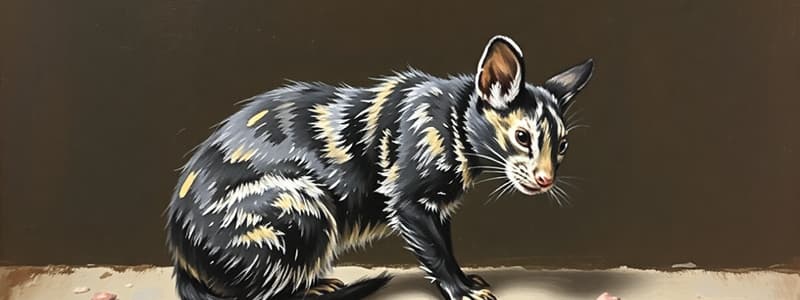Podcast
Questions and Answers
What principle of the 3Rs focuses on reducing the number of animals used in research?
What principle of the 3Rs focuses on reducing the number of animals used in research?
- Refinement
- Replacement
- Reduction (correct)
- Rehabilitation
Which of the following methods can be used to replace the use of animals in research?
Which of the following methods can be used to replace the use of animals in research?
- Computer modeling
- In vitro testing
- Human volunteer studies
- Both A and B (correct)
Which refinement technique is intended to minimize animal suffering during research procedures?
Which refinement technique is intended to minimize animal suffering during research procedures?
- Improved surgical techniques
- Providing social enrichment
- Using less invasive methods
- All of the above (correct)
Animal welfare standards in research mainly aim to ensure which of the following?
Animal welfare standards in research mainly aim to ensure which of the following?
What is the primary goal of the Replacement principle in the 3Rs?
What is the primary goal of the Replacement principle in the 3Rs?
Which of the following is a common statistic about animal usage in research?
Which of the following is a common statistic about animal usage in research?
Why is it necessary to conduct preliminary research using animals before human trials?
Why is it necessary to conduct preliminary research using animals before human trials?
What aspect of agricultural research is often assessed to improve cow welfare?
What aspect of agricultural research is often assessed to improve cow welfare?
Which of the following is not one of the 3Rs principles in animal research?
Which of the following is not one of the 3Rs principles in animal research?
What is the primary function of the Animal Care Committees (ACCs) in research facilities?
What is the primary function of the Animal Care Committees (ACCs) in research facilities?
Which animal accounts for the majority of research animals used in Canada?
Which animal accounts for the majority of research animals used in Canada?
What must researchers do before starting any animal research?
What must researchers do before starting any animal research?
How does Post-Approval Monitoring contribute to animal research?
How does Post-Approval Monitoring contribute to animal research?
What percentage of research animals used in Canada are dogs, cats, rabbits, and non-human primates combined?
What percentage of research animals used in Canada are dogs, cats, rabbits, and non-human primates combined?
Which of the following statements about the oversight of animal research is correct?
Which of the following statements about the oversight of animal research is correct?
Which method is considered a replacement strategy in animal research?
Which method is considered a replacement strategy in animal research?
Which statement best describes the principle of reduction in animal research?
Which statement best describes the principle of reduction in animal research?
What is meant by the principle of replacement in animal research?
What is meant by the principle of replacement in animal research?
Which of the following techniques is considered a refinement method in animal research?
Which of the following techniques is considered a refinement method in animal research?
What do the 'Three Rs' in animal research prioritize?
What do the 'Three Rs' in animal research prioritize?
Which of the following is considered a relative replacement strategy?
Which of the following is considered a relative replacement strategy?
Which of these practices significantly contributes to quality animal care in research?
Which of these practices significantly contributes to quality animal care in research?
In what way does the principle of refinement enhance animal welfare?
In what way does the principle of refinement enhance animal welfare?
Which method is NOT part of a replacement strategy in animal research?
Which method is NOT part of a replacement strategy in animal research?
Study Notes
The Canadian Council on Animal Care (CCAC)
- Oversees and certifies exemplary care of laboratory animals in Canada.
- Develops guidelines and policies.
- Conducts mandatory reviews and assessments of animal research facilities and programs.
- Requires adherence to "3Rs" (Reduce, Refine, Replace).
- Accreditation is required for academic institutions using animals.
Animal Research Practices
- Ethical and regulated, with strict guidelines for humane treatment.
- Researchers must apply to an Animal Care Committee (ACC) and justify their research plans.
- ACCs review proposals and require changes for improved animal care and welfare.
- Veterinarians and trained animal technicians care for and oversee animal use.
- Facilities are regularly inspected for upkeep.
- ACCs and vets can stop experiments or intervene if needed.
- Post-approval monitoring ensures research is conducted as described.
Animal Research Data
- Mice and fish comprise the majority of research animals used in Canada.
- Dogs, cats, rabbits, and non-human primates account for less than 0.7 percent of total animals used.
- Many animals in clinical trials and teaching programs are not used for invasive research.
The 3Rs
- Reduce: Minimize the number of animals used while ensuring statistically significant results.
- Refine: Modify procedures to minimize pain and distress, such as optimized housing, less invasive techniques and improved anesthesia.
- Replace: Use alternatives to animals whenever possible, such as computer simulations, tissue cultures, or lower sentience animals.
Examples of Animal Research
- Cancer Research: Investigate the causes, diagnosis, and treatment of cancer using animal models.
- Agricultural Research: Study dairy production to improve cow health and welfare.
- Wildlife Research: Track endangered wolves and caribou populations.
- All research must be ethically justified and conducted according to ethical guidelines.
Studying That Suits You
Use AI to generate personalized quizzes and flashcards to suit your learning preferences.
Related Documents
Description
This quiz explores the ethical frameworks and regulations governing animal research in Canada, particularly focusing on the Canadian Council on Animal Care (CCAC). It covers the '3Rs', the role of Animal Care Committees, and the responsibilities of researchers and veterinarians in ensuring humane treatment of laboratory animals.




